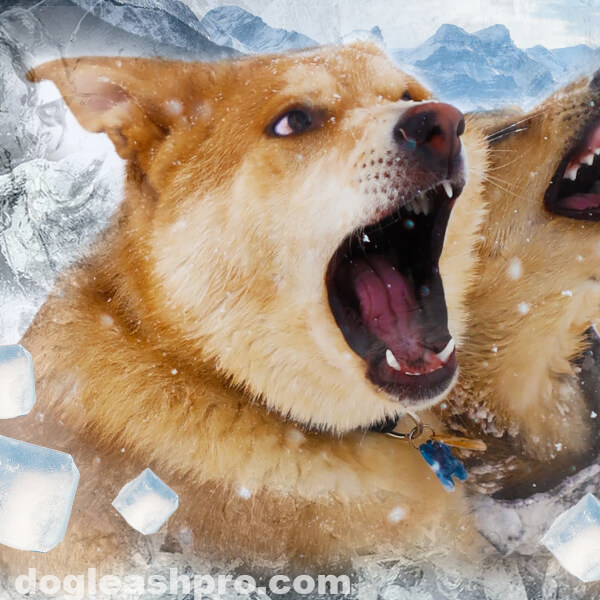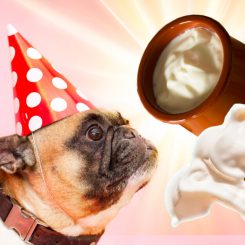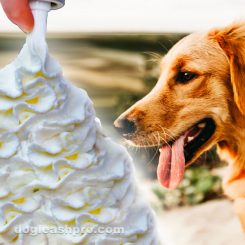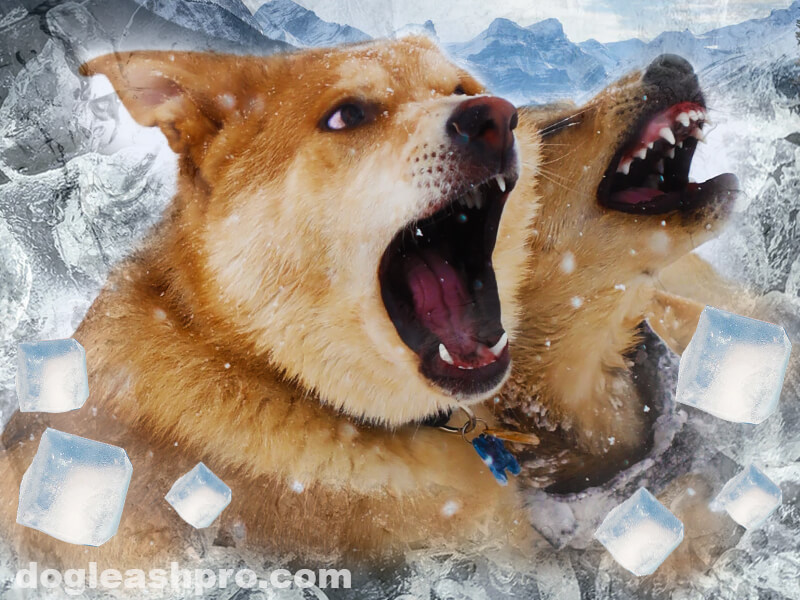
Summer is almost here and the temperature is rising. I was walking my two dogs yesterday and bought Boba and a vanilla ice cream cone on my way home. Unfortunately, I didn’t eat the ice cream fast enough and it started to melt. My two pups were eyeing me the whole time because they wanted some but I was afraid they may get brain freeze from eating it.
Can dogs get brain freeze? Yes, dogs can get brain freeze! But it is not potentially life-threatening to their health. Although, it is an unpleasant experience.
Table of Contents
Can dogs get brain freeze?
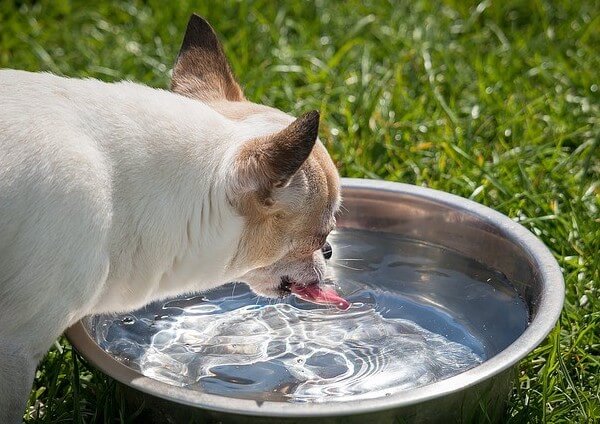
Dogs can definitely get brain freeze, but luckily, it is not life-threatening and does not impact their overall health. However, it is an unpleasant experience for that brief moment.
And why would any pet-lover want to cause any type of discomfort to their furry friends, right?
When your human friend gets brain freeze, you laugh about it and you may sometimes try to achieve brain freeze on purpose to make them laugh.
It is completely the opposite when dogs get brain freeze. They don’t understand what is happening and will not stop eating the ice-cold food if they are hungry or enjoying the taste.
Brain freeze from eating large amounts of cold food too fast is not life-threatening but there are several reasons why a dog can get brain freeze. Some of these reasons are more serious than others. And if left untreated could prove detrimental to your dog’s health.
5 Reasons Dogs Get Brain Freeze
Dogs getting brain freeze could be for a number of reasons. Let’s take a look at five reasons why a dog may get brain freeze.
- Ice-cold foods: When our furry friends eat too fast and in large quantities, there’s a high chance that they will get a brain freeze.
- Arthritis: Certain forms of arthritis may affect the cranial nerve sheaths in dogs and cause symptoms identical to brain freeze.
- Chemical imbalance: If there is a dietary or chemical imbalance, the signals sent to the brain can get confused and result in your pooch getting a brain freeze.
- Ice cold water: On a hot day, the contrast between warm or hot air and drinking ice cold water can create brain freeze in our four-legged friends.
- Cranial Nerve Disorders: Idiopathic Trigeminal Neuritis (IDT) is just one of many facial nerve problems in canines. IDT is more common in older dogs. If your pups get limp in their face or develop problems such as drooling or jaw paralysis, we highly recommend that you bring your pooch to the vet immediately for a proper diagnosis.
There are also other types of problems that can affect your dogs’ trigeminal nerves and give them headaches. If no cold drinks or foods have been consumed, see the vet as soon as possible.
Do dogs get brain freeze from eating ice cream?

Maybe. It just depends on whether the ice cream has melted or is still frozen rock hard. Some dogs are far more sensitive to eating ice-cold ice cream than others.
Picture this: You are at the park with your pooch. You are joyfully about to start licking away at a recently purchased chocolate and vanilla ice cream bar, but it’s so hot, the ice cream is melting faster than you can lick.
Then before you know it, the remaining ice cream drops off the stick and onto the ground. In a flash, your hound is on it and licks it all down. Chances are slim that your pooch will suffer brain freeze in this scenario.
But what if you serve your canine friends a dollop of ice-cold, frozen, dairy-based ice cream? You think the treat will cool your pup down on a hot summer day, but you can’t stop him from gulping the entire portion down in seconds.
Now it’s likely your dog will get a serious brain freeze in this situation. And not only is your poor pooch going to suffer from possible pain in his eyes, nose, and forehead, his digestive system will take a beating as well.
Most dog lovers know that dogs aren’t designed to digest dairy products like ice cream. This is because most dogs are lactose-intolerant so they lack the lactase enzyme that is responsible for breaking down lactose found in milk products.
If your furry friends are given a dollop of ice cream and it takes them a while to eat it, they shouldn’t experience brain freeze. It takes longer than a few seconds for a dog to eat a bowl of ice cream. They may try and take bites but then realize it’s easier to lick at it.
Some dogs may get a brain freeze from ice cream but they are far more likely to get it from eating a slushie or a bowl of crushed ice. It also depends on the breed of the dog.
My friends and I have tried this experiment (not purposely) and it became obvious that the larger dog breeds did not get brain freeze when eating ice cream. Even some smaller dogs did not seem to get it as well.
However, there are a few cases of dogs getting brain freeze and they felt instant pain. Their behaviors showed that it was not pleasant for them.
What is a brain freeze?
Brain freeze is a sharp, stabbing pain in the head, forehead, or eye area. It is experienced by dogs when they eat ice cream too fast or bite and swallow it, as opposed to licking it. The nickname given to this action and reaction is called brain freeze.
It is a short-term nerve pain caused by local vasoconstriction in the capillaries located in the roof of your dog’s mouth. The cold stimulus makes the nerves in this area extra sensitive.
When this happens your pooch experiences a tingling sensation in the forehead, behind the eyes, or in the lower jaw. This tingling sensation can also be experienced as a sharp stabbing pain.
In healthy dogs, this may just be a bit uncomfortable. But for older dogs or unhealthy dogs, the sensation can be a bit more intense or painful.
How does brain freeze work?
Brain freeze happens because the trigeminal nerves are stimulated by extreme and sudden cold. The trigeminal nerves are connected to the cranial nerves and send sensation to the dog’s face. When brain freeze occurs, your furry friend’s lower jaw, eyes, and forehead are most affected.
All mammals have 12 cranial nerves, and dogs are mammals, so it seems logical that if a human can get brain freeze, so can a dog. When you put a large amount of ice-cold food in your dog’s mouth, the roof of the mouth will feel the cold immediately.
This sends pain signals to the brain through capillaries in the nervous system. The brain relays this back to the trigeminal nerves. And different degrees of pain get experienced in the face. The sudden sharp pain can hit behind the eyes, in the lower jaw, or on the forehead.
Handy Hint: How owners prepare their dog’s food is very important. For instance, our furry friends should eat certain foods or treats raw like Pig Feet instead of it being cooked. Another example is that we should allow the refrigerated food to get to room temperature before serving it to our pooch.
Do dogs get brain freeze after eating other ice-cold food and water?
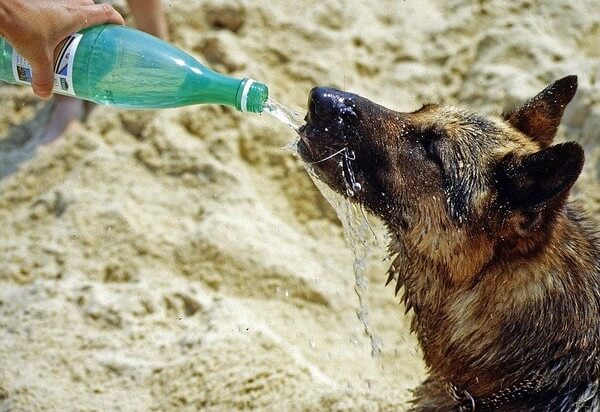
Yes, any food or drink that your dog ingests too fast, and in large enough quantities, can give them a brain freeze. This is especially true when the food in question needs to be chewed rather than licked.
Some pet owners cook food for their dogs once or twice a week. This food is kept in the fridge. If the food is taken out of the fridge, it is best to give the food enough time to warm up to room temperature. This way if your pooch is hungry, they will gulp down food that is room temperature.
It’s important to keep in mind that our furry friends don’t eat slowly or take small bites of their meal, especially when they are hungry. This is why you shouldn’t feed your pooch food that just came out of the fridge. Doing so can cause brain freeze in dogs.
On a hot or warm day, you may think you are giving your furry friends a treat by filling their water bowl with ice-cold water. However, your pooch can get a brain freeze from this.
Dogs can get extremely thirsty on a hot summer day and when they are thirsty, they will drink the ice-cold water very fast and a lot of it. As a result, they will get a brain freeze.
READ NEXT: Why Does My Dog Nudge His Food Bowl Before Eating? 10 Reasons Why!
Do dogs suffer from brain freeze?
Yes, dogs do suffer from brain freeze. It is not something that has been scientifically studied and proven, but it is recognized by many veterinarians. Vets around the world have treated dogs for brain freeze so they understand that it does happen. Brain freeze can cause discomfort as well as emotional distress for any dog.
As mentioned before, there may be different reasons why a dog would get brain freeze. Not all brain freeze is caused by eating cold food or ice cream.
If you spend a lot of time with your furry friends, you will see signs and symptoms that are out of place. If your pups look like they are getting brain freeze, but they haven’t eaten anything ice-cold, be sure to pay closer attention.
Consult with your vet as soon as possible if you suspect any change in behavior.
Dog brain freeze: What might it look like?
When dogs get a brain freeze as a direct result of eating ice or ice cream, they will react immediately. You will see your pups leaning down with their front paws and begin to rub their head on the ground.
They will rub their head as if they have itchy ears and will move from side to side. What they are trying to do is get rid of the sudden pain sensation they are feeling in their head. This behavior is similar to when your pups get out of the water and rub their ears on the ground from side to side.
A dog gets brain freeze from drinking ice cold water or eating ice-cold food because of this very reason:
In between bites, he is taking in warm air. This sudden change from warm to ice-cold, and the repetition thereof, causes his capillaries and nerves on the roof of his mouth to experience widening and narrowing in bursts. This results in local vasoconstriction and the dog will experience pain, even though it will be for a very short period.
When dogs experience this brief pain, they may move away from their bowl of ice cream or ice-cold food. You may see their heads laying limply on the floor. This is another type of reaction to brain freeze. A dog may go limp and afterward appear lethargic.
Dogs getting brain freeze: When to contact your vet
If your pup starts to uncontrollably move around in circles, it’s best to take him to the vet immediately as this condition could be due to an inflammation in his brain.
When dogs get brain freeze for the first time and it is not from eating anything cold, it could be due to other health issues you were not aware of. Keep in mind that when the brain freeze condition gets severe, it can stress out your pups. Due to this stress, other health issues can also get triggered.
Be sure to monitor your furry family members closely. If you notice your dog’s face has become paralyzed or he’s feeling very lethargic, it’s time to contact your vet.
How to prevent brain freeze in dogs?
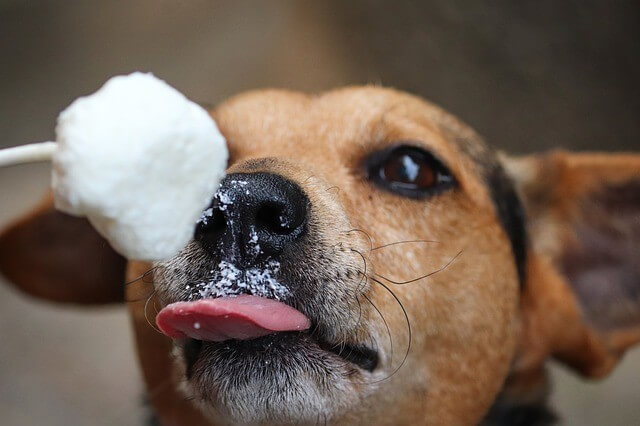
The easiest way to prevent your dogs from getting brain freeze is to not feed them ice cream or ice-cold food.
Here are some helpful tips to prevent brain freeze in dogs:
- Reduce portion sizes of the cold food or ice cream.
- Feed them by hand to control the speed at which they are eating the frozen snack.
- Give them an ice cube to chew on instead of a dairy frozen dessert.
- Fill the water bowls with cool water, not ice-cold water.
- Feed them a mix of frozen snacks with room temperature snacks. This will balance things out.
How to cure brain freeze in dogs?
You see your pooch is suffering from brain freeze. Here are two things you can do to heat up the roof of their mouth or cool down the overall temperature of their body:
Solution 1: Because brain freeze is caused by cold temperature in the roof of the dog’s mouth, which triggers a cold-stimulus headache, one thing you can do is to feed him a warm snack that requires him to chew or lick. This will reverse the nerve sensations and reduce the pain.
Solution 2: Keep him calm by gently massaging his forehead and stroking him gently. This will help him emotionally and physically.
Alternative ways to cool down your dog
Ice cream might be a favorite summertime snack for cooling down humans but for our fur buddies, it is not the case. Here are some helpful hacks to keep them cool:
- Take them for a swim. Some doggy parks have water amenities. If you have a swimming pool or live close to the beach, nothing beats a full-body soak in the ocean to cool down your dogs.
- Bring them indoors if you have cool air-conditioned rooms.
- Some homes are tiled and dogs will enjoy lying on cool tiles to keep cool.
- Lay on elevated dog beds so your pups can relax and feel cool.
- Fill the water bowl with cool water and don’t add ice cubes. Keep the water in a shaded area or replace it once or twice a day if it gets too warm.
- Use a “cold-pack” or a damp hand towel to cool down your dog’s body. Lightly place the towel on his forehead. Dip it in cool water if you feel the towel has lost its coolness.
When it comes to keeping your pups cool during the warm or summer seasons, elevated dog beds or Best Chew Proof Dog Beds are extremely helpful. The air circulates all around your canine friends when they sleep or relax.
What are some dog-friendly treats to give your dog instead?
Dairy, chocolate, raisins, and certain nuts are not ideal foods to give dogs as snacks. If you want to give your fur babies a delicious frozen snack, try making your own version of doggy ice cream.
Here are some options to consider:
- Peel a banana and place it in a plastic bag. Freeze. Remove from the freezer and add some papaya. Dogs will love this cool semi-frozen snack. And papaya contains digestive enzymes that are beneficial to your dog’s gut.
- Blend peanut butter and bananas, or other fruit that you know your dog likes, and freeze it in small portions.
- Many dog biscuits are wheat-free and made with nutritionally balanced ingredients. Crumble up two or three biscuits and serve on top of the frozen fruit treat.
- Use watermelons, cantaloupes, and strawberries. Make ice lollies and give this to your pups instead of dairy ice cream. Beware of store-bought lollies. They are either too high in sugar or may contain xylitol, which is toxic to dogs.
If your pooch truly loves ice cream, here is a canine-friendly ice cream treat we highly recommend. Our dogs love these:
Beyond brain freeze
Dairy ice cream is bad for your fur friends because they are not designed to properly digest dairy products.
Feeding your lovable mutt too many human treats can cause stomach aches and in rare instances, they can get pancreatitis, which is inflammation in the pancreas.
Make sure to bring your four-legged friends to the vet if they are old or starting to show signs of paralysis in the face and jaw. If they are not old and seem to be getting lethargic, this is also a sign to check your dog’s diet or get them to the vet for a general check-up.
Conclusion
Did you find this article helpful and informative? Let us know. Remember to keep your pooch cool on extremely hot summer days by following the advice above.
As much fun as it is to share treats with your furry friends, remember that their health comes first and is more important. It is not entertaining to feed your dogs ice cream just to see how they react by getting a brain freeze.
Make sure to always provide plenty of water for them to drink or a cool area for them to lay down in. And if you see them behaving strangely without having eaten ice-cold food, call your vet for advice.
Resources:
https://www.sciencedaily.com/releases/2013/05/130522095335.htm
https://en.wikipedia.org/wiki/Cold-stimulus_headache

With over five years of specialized experience as an animal writer, my expertise lies in dog nutrition, health, behavior, grooming, and training. I am dedicated to delivering helpful and informative content that caters to the well-being of our furry friends. My primary goal is to empower pet owners with knowledge and ensure our canine companions thrive in health and happiness. In my free time, I love volunteering at local dog rescue centers.
